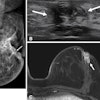Breast MRI is a sensitive modality that finds cancers mammography or ultrasound can miss. But when it's used preoperatively in women who have already been diagnosed, it may cause more trouble than it's worth -- such as longer wait times for surgery and unnecessary mastectomies, according to a new study published in JAMA Oncology.
The use of preoperative breast MRI increased eightfold between 2003 and 2012, Canadian researchers found, despite the fact that there are no recommendations for routinely using the modality before breast cancer surgery. Current guidelines suggest bilateral mammography as the primary preoperative imaging modality for women with breast cancer, followed by ultrasound, if necessary.
So why the surge in preoperative use of breast MRI?
"Indication creep" could be one reason -- that is, the tendency for clinicians to use a test beyond its original indications, according to lead author Dr. Angel Arnaout and colleagues from the University of Ottawa in Ontario. Other reasons could include the increased availability of MRI scanners, rising patient demand, institutional pressure to use expensive capital equipment, or even radiologist self-referral for diagnostic imaging services (JAMA Onc, September 24, 2015).
But in an era of intense efforts to contain healthcare costs, this growth is unsustainable, they wrote.
"The increased sensitivity of breast MRI is achieved at the cost of lower specificity; in practice, this translates into more confirmatory imaging and biopsies needed to rule out a diagnosis of cancer," the group wrote. "Implications of this include increased associated resource use and cost, as well as potential harm to women through the cascade of additional imaging and invasive procedures for diagnostic resolution that are associated with increased anxiety and medical visits for the patient."
The downsides of preop MR
For the study, Arnaout's team used administrative healthcare databases in Ontario to identify 53,015 women who had surgery for early-stage breast cancer between 2003 and 2012.
The researchers found that 14.8% of the women had preoperative MRI, and most patients (65%) underwent breast-conserving surgery. The use of preoperative MRI increased from 3% of patients newly diagnosed with breast cancer in 2003 to 24% of patients in 2012.
Patient-related factors were associated with higher preoperative MR use, such as younger age and higher socioeconomic status. On the clinician side, factors included working in a teaching hospital and having fewer years of surgical experience.
Regarding downsides to preoperative breast MR, the researchers found that it was associated with a greater likelihood of postdiagnosis breast imaging, breast biopsies, and other further imaging to look for distant metastatic disease, as well as mastectomy, contralateral prophylactic mastectomy (in which the opposite, healthy breast is also removed, which some studies have determined offers little or no survival benefits), and a more than 30-day wait for surgery.
"Breast cancer ... is associated with high initial and ongoing costs compared with other tumor types, and the use of advanced medical imaging is a major contributing component to these costs," the team wrote. "The increase in use of [preoperative breast MRI] has occurred without strong evidence of benefit for initial or long-term surgical or oncological outcomes."
| Odds of short-term surgical outcomes after preoperative breast MRI | |
| Short-term postsurgical outcome | Odds ratio |
| Waiting more than 30 days between diagnosis and surgery | 2.52 |
| Further breast imaging | 2.09 |
| Needle biopsy | 1.74 |
| Having a mastectomy | 1.73 |
| Further imaging to identify metastatic disease | 1.51 |
| Having a contralateral prophylactic mastectomy | 1.48 |
The researchers conceded that their study had some limitations. For example, it used claims-based registry data, which do not include clinical indications for the preoperative breast MR exam or any of the outcomes associated with its use. It's also possible that the increase in additional imaging and biopsies was a result of general overtreatment rather than in response to preoperative MR.
"Although we were unable to provide long-term outcomes in this dataset for recurrence and survival, it is our hope to be able to do so in a future study," Arnaout and colleagues wrote.
The problem of overtreatment
The study suggests that the increased use of preoperative MRI in women newly diagnosed with breast cancer may contribute to a general problem of overtreatment, wrote Dr. Habib Rahbar from the University of Washington and Dr. Constance Lehman, PhD, from Massachusetts General Hospital in a related commentary. But it's important to interpret the study results carefully.
"Because the authors did not report MRI results (e.g., if the MRI was interpreted as positive or negative), the extent to which the MRI might have influenced additional tests or more aggressive surgery is not clear," Rahbar and Lehman wrote. "It is likely that at least some extent was a result of general more aggressive testing and treatment in the subset of patients receiving MRI rather than a specific response to MRI results."
It may be that MRI would be better used to develop cutting-edge treatment options, the two concluded.
"Because MRI can detect occult disease with high sensitivity, future research might explore its role in novel treatment approaches," they wrote. "It is in this role in precision diagnostics and risk stratification that advanced imaging techniques may hold the greatest promise."




.fFmgij6Hin.png?auto=compress%2Cformat&fit=crop&h=100&q=70&w=100)




.fFmgij6Hin.png?auto=compress%2Cformat&fit=crop&h=167&q=70&w=250)











